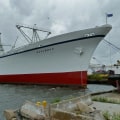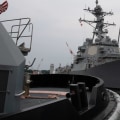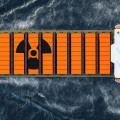Nuclear-powered naval vessels require a lengthy reconditioning process known as refueling and reconditioning (ROH) to replace spent nuclear fuel with new fuel and perform general maintenance, repair, refurbishment, and modernization. This process usually takes one to two years for submarines and up to almost three years for an aircraft carrier. In the United States Navy, the time periods between RoHS on a ship have historically varied from approximately 5 to 20 years for submarines and 25 years for Nimitz class aircraft carriers. For modern submarines and aircraft carriers, RoHs are generally carried out about half their useful life.
The nuclear fuel cycle begins with uranium being prepared for use in nuclear reactors. This is followed by the enrichment of the isotope U-235 to operate efficiently. The enriched UF6 is sealed in containers and transported to a nuclear reactor fuel assembly plant. Here, UF6 is heated to gaseous form and then chemically processed to form powdered uranium dioxide (UO).
The UO is then formed into fuel assemblies which are stored on-site in new fuel storage tanks until needed by reactor operators. At this stage, uranium is only slightly radioactive, and essentially all of the radiation is contained within the metal tubes. Typically, reactor operators change approximately one-third of the reactor core (40 to 90 fuel assemblies) every 12 to 24 months. Once a reactor core has become critical, meaning that it has been used during the operation of a reactor, highly radioactive nuclear fission products have formed in the core, and the core has become highly radioactive.
Refueling involves taking the spent core out of the reactor and putting in a new core with new nuclear fuel. The reactors aboard the George Washington contain enough nuclear fuel to fully power the ship and all its needs on board for approximately 20 years. The replenishment cycle is quoted at 6-7 years, or with a capacity factor of 65%, replenishment is every 7-10 years, the review at 20 years, for a lifespan of 60 years. A particularly lengthy refueling, maintenance and modernization process for a nuclear aircraft carrier can last up to almost three years and is known as a refueling complex (RCOH) overhaul. Once fuel assemblies are manufactured, trucks transport them to reactor sites.
At this point, the power plant heats up or restarts to the desired operating temperature and pressure so that it can start up when it is ready. Because it is so radioactive, removing a nucleus with spent nuclear fuel from a reactor requires elaborate radiological handling precautions. The final step in the nuclear fuel cycle is the collection of spent fuel assemblies from temporary storage sites for final disposal in a permanent underground reservoir.



